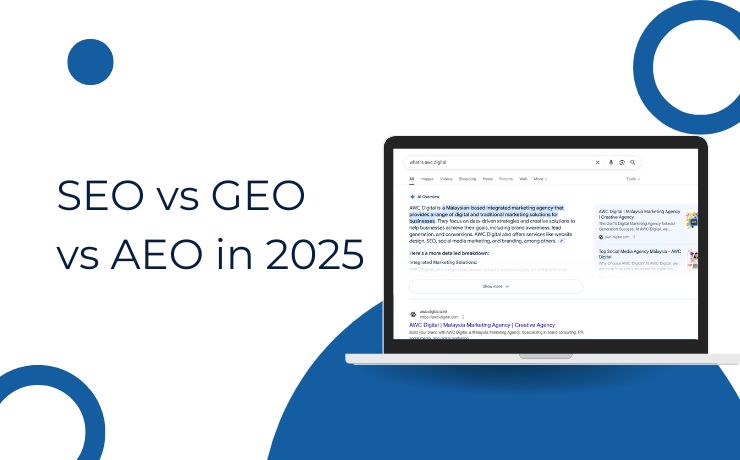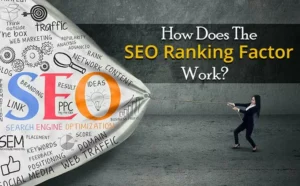
SEO, GEO & AEO in 2025: A Complete Guide to AI-Era Search Visibility
The search landscape is undergoing its fastest transformation in decades. Traditional Search Engine Optimization (SEO) still drives high-value organic traffic, but Generative Engine Optimization (GEO) and Answer Engine Optimization (AEO) are now critical for capturing visibility in AI-powered search results.
AI-driven platforms such as Google’s Search Generative Experience (SGE), ChatGPT, Bing Chat, and Perplexity are shifting user behavior. Instead of listing links, these tools generate direct, conversational answers — often without requiring a click. Similarly, voice search and featured snippets provide instant answers that bypass the need to visit a website.
For businesses, this means relying on SEO alone is no longer enough.
To remain competitive in 2025, brands must integrate:
-
SEO – to rank in traditional search results.
-
GEO – to be cited as a trusted source in AI-generated answers.
-
AEO – to secure top placement in featured snippets, voice search, and direct-answer formats.
This unified approach — often called Search Everywhere Optimization — ensures your brand appears wherever customers are searching, whether they’re typing into Google, speaking to Alexa, or prompting an AI chatbot.
What Are SEO, GEO, and AEO?
To build a winning AI-era search strategy, it’s essential to understand how each discipline works and the platforms they target.
While they share the goal of increasing search visibility, their approaches, technical requirements, and success metrics differ.
Why This Matters in 2025
Search is no longer a single-platform game. Your content must be discoverable across traditional search engines, AI-powered platforms, and direct-answer environments.
By aligning SEO for rankings, GEO for AI citations, and AEO for instant answers, your brand can dominate visibility across the full search spectrum.
Why SEO, GEO, and AEO All Matter in 2025
In 2025, search visibility is no longer determined by Google rankings alone.
User search behavior is shifting rapidly:
-
AI-driven searches are growing: A 2025 Gartner report predicts that 20% of all online queries will be answered directly by generative AI platforms by 2026.
-
Voice search adoption continues to rise, with 8.4 billion voice assistants in use globally (Statista), increasing demand for clear, spoken-answer content.
-
Click-free search experiences are expanding, with Google’s SGE and Bing Chat delivering information without requiring a website visit.
If your content only targets one of these areas, you risk losing market share to competitors who appear across all search touchpoints.
How Each Plays a Role
-
SEO captures high-intent visitors from traditional SERPs, delivering traffic and conversions.
-
GEO ensures your brand is embedded into AI-generated answers, building trust and recall even when no click occurs.
-
AEO secures instant authority by “owning the answer” in featured snippets and voice responses.
The Business Impact
By combining all three:
-
Increased brand presence — Users encounter your brand whether they click, skim, or listen to an answer.
-
Improved trust signals — Consistent, accurate mentions across platforms reinforce authority.
-
Future-proof visibility — Early adoption of GEO and AEO prepares your brand for upcoming algorithm changes and AI integrations.
What SEO, GEO, and AEO Have in Common
While Search Engine Optimization, Generative Engine Optimization, and Answer Engine Optimization target different platforms, they share core principles that ensure success across any search environment.
These principles not only align with Google’s quality guidelines but also strengthen your E-E-A-T profile (Experience, Expertise, Authoritativeness, Trustworthiness).
1. Audience-First Strategy
Every approach starts with understanding user intent — knowing what questions your audience asks and how they search for solutions.
Example: Our SEO content strategy services start with in-depth keyword and intent research to map your audience’s journey.
2. High-Quality, Accurate Content
Whether it’s for a Google search or an AI-generated response, content quality is non-negotiable.
-
Fact-checked
-
Well-researched
-
Supported by reputable sources and expert quotes
3. Clear and Logical Structure
Search algorithms and AI models both prioritize well-organized information:
-
Headings (H1–H3) that reflect the content accurately
-
Short paragraphs for readability
-
Bullet or numbered lists for quick scanning
4. Ongoing Optimization
Search trends, AI algorithms, and ranking signals evolve constantly. Regular content audits help:
-
Update statistics and examples
-
Refresh outdated references
-
Improve structure for readability
5. User Experience as the Ultimate Test
Fast load speeds, mobile responsiveness, and easy navigation improve engagement signals and trust — key ranking factors for both traditional and generative engines.
Example: Our technical SEO services ensure your site’s speed, mobile usability, and crawlability meet Google’s best practices.
Key Differences: SEO vs GEO vs AEO
Pro Tip: The most effective pages combine all three — SEO for rankings, GEO for AI readiness, and AEO for instant answers — ensuring visibility across traditional search, AI platforms, and voice assistants.
Content Tactics That Work Across SEO, GEO, and AEO
While SEO, GEO, and AEO each have unique technical requirements, certain content practices give you an edge across all three. These tactics strengthen your rankings, improve AI citation chances, and increase the likelihood of winning featured snippets or voice search results.
1. Use Extractable Headings
Clear, descriptive headings help both search engines and AI models identify your main topics quickly. They also make your content easier for users to scan. For example, use a heading like “What is Generative Engine Optimization (GEO)?” instead of something vague like “Understanding GEO.”
2. Add Authoritative References
Both Google and AI-driven platforms reward content backed by credible sources. Include references to industry studies, reputable websites, or expert quotes. For example, “According to a 2025 Gartner report, 20% of queries will be answered by generative AI by 2026” adds authority and trustworthiness.
3. Include Data-Driven Insights
AI models prefer fact-rich content, and readers respond well to tangible results. Where possible, include relevant statistics, benchmarks, or case studies. For instance, you might note, “Our client increased snippet coverage by 32% in just 90 days through structured content optimization.”
4. Use Conversational Q&A Blocks
Adding FAQ sections with natural, question-based headings mirrors how people speak and search, which is particularly effective for voice queries and AI extractions. Questions like “How does GEO differ from SEO?” followed by a concise, direct answer can work across all platforms.
5. Implement Schema and Structured Data
Structured data, such as FAQ schema or Article schema, helps search engines and AI better understand and display your content. This increases your eligibility for rich results, featured snippets, and higher AI citation frequency.
6. Summarize with Key Takeaways
Ending major sections with bullet-point summaries helps AI extract your main points and makes it easier for readers to remember them. For example, after explaining a complex concept, list three to four bullet points that capture the essence.
7. Conduct Regular Content Audits
Search algorithms and AI models value fresh, relevant content. Review your top-performing pages quarterly to update statistics, refresh internal links, and adjust structure for clarity. This ongoing effort keeps your content competitive across all search formats.
Pro Tip: By combining at least three of these tactics on every page, you create content that works equally well for Google’s ranking signals, AI’s citation logic, and the quick-answer needs of voice search users.
Technical Enhancements for AI-Era Search
Content quality is only part of the equation. For your SEO, GEO, and AEO efforts to perform at their best, you also need a strong technical foundation. These enhancements make your site more discoverable, more understandable, and more usable for both human visitors and AI-driven platforms.
1. Apply Schema Markup Strategically
Schema markup helps search engines and AI models understand the structure and meaning of your content. Use Article schema for blog posts, FAQ schema for Q&A sections, and HowTo schema for instructional content. This not only increases your eligibility for rich results but also improves your chances of being cited in AI-generated answers.
2. Add Anchor Links for Easy Navigation
Anchor links allow users — and AI — to jump directly to the most relevant section of your content. For example, linking directly to “Step 3: Optimize for AI Citation” in a guide makes your page more user-friendly and helps AI models extract targeted answers.
3. Maintain Freshness Signals with RSS Feeds
An up-to-date RSS feed tells search engines and AI platforms that your site is active. It’s particularly useful for news, industry updates, and regularly refreshed blog content. This can help with recency signals, which many AI-driven engines now value highly.
4. Optimize for Accessibility and Speed
Core Web Vitals, mobile responsiveness, and accessibility compliance (like alt text for images and captions for videos) directly impact user experience. Faster, more accessible websites reduce bounce rates, which benefits SEO and improves the likelihood of AI platforms selecting your content.
5. Guide AI Crawlers with Robots.txt and llms.txt
While robots.txt is well-known for guiding search engine crawlers, llms.txt is emerging as a way to provide instructions specifically for large language models (LLMs). It can help you control which parts of your content are used by AI systems, giving you more influence over your brand’s representation.
6. Provide Complete Multimedia Metadata
For images, include descriptive alt text that incorporates relevant keywords naturally. For videos, use transcripts and captions. These elements make your media searchable and understandable, both for traditional search engines and AI platforms.
7. Audit Link Relevance and Structure
Internal links should connect related topics, while external links should point to reputable, authoritative sources. For advanced GEO optimization, consider running vector relevance checks to ensure your linked content closely matches the main topic — improving semantic signals to AI models.
Pro Tip: Treat technical optimization as an ongoing process, not a one-time fix. Schedule quarterly technical audits to ensure your site stays aligned with both traditional SEO best practices and emerging AI-driven discovery methods.
Measuring Success Across All Three Lanes
A well-executed SEO, GEO, and AEO strategy only works if you can measure its impact. Tracking the right KPIs tells you whether your content is performing in traditional search, AI-driven answers, and direct-answer formats — and where to refine your approach.
1. SEO Performance Metrics
Traditional SEO focuses on ranking, traffic, and engagement. These are the core indicators to monitor:
-
Keyword Rankings: Track positions for your primary and secondary target keywords.
-
Organic Traffic: Measure growth in non-paid visits from search engines.
-
Click-Through Rate (CTR): Indicates how compelling your titles and meta descriptions are in SERPs.
-
Engagement Metrics: Monitor average session duration, bounce rate, and pages per session.
-
Conversions: Leads, purchases, or sign-ups originating from organic search.
Example KPI Goal: Increase organic traffic by 20% in six months while maintaining a CTR above 4% for key landing pages.
2. GEO Performance Metrics
Generative Engine Optimization focuses on brand visibility inside AI-generated answers and the quality of those mentions.
-
AI Citation Frequency: How often your brand or content appears as a cited source in AI answers.
-
Share-of-Voice (SoV) in AI Results: Your brand’s proportion of mentions compared to competitors in AI-generated responses.
-
Sentiment Analysis: Whether your brand mentions in AI outputs are positive, neutral, or negative.
-
Referral Traffic from AI Tools: Clicks from platforms like ChatGPT, Perplexity, or Bing Chat (where tracking is possible).
Example KPI Goal: Achieve a 15% share-of-voice in relevant AI responses within targeted industry topics.
3. AEO Performance Metrics
Answer Engine Optimization is about owning quick-answer opportunities like featured snippets and voice results.
-
Featured Snippet Win-Rate: The percentage of targeted queries where your content holds the snippet position.
-
Voice Search Coverage: How often your content is selected for voice assistant answers.
-
FAQ Rich Result Visibility: The number of queries where your FAQ schema is displayed in search.
-
Direct Answer Click-Throughs: Traffic from queries that trigger People Also Ask or instant answers.
Example KPI Goal: Secure featured snippet placement for at least 30% of targeted quick-answer queries.
4. Bringing It All Together
The most effective measurement approach is side-by-side tracking of SEO, GEO, and AEO metrics in one dashboard. This lets you:
-
Spot content that performs well in one channel but underperforms in another.
-
Identify opportunities to tweak structure, add schema, or enrich with authoritative data.
-
Allocate resources to tactics that deliver the best multi-platform return.
Pro Tip: Review metrics monthly but conduct a quarterly deep-dive to assess trends and make strategic adjustments. SEO often shows steady, compounding gains, while GEO and AEO performance may shift rapidly as AI models evolve.
90-Day Implementation Roadmap for SEO, GEO, and AEO
A winning Search Everywhere Optimization strategy doesn’t need to be overwhelming. By breaking it into focused phases, you can steadily build momentum and see measurable improvements in traditional search rankings, AI citations, and quick-answer visibility.
Weeks 1–2: Audit and Benchmark
Before you can improve performance, you need to know where you stand.
-
Content Inventory: Identify your top-performing pages by traffic, rankings, and conversions.
-
SEO Baseline: Record keyword rankings, organic traffic levels, and CTR.
-
GEO Baseline: Check current AI citation frequency and share-of-voice using available tools.
-
AEO Baseline: Identify how many target queries you currently own in featured snippets or voice search.
-
Gap Analysis: Pinpoint which high-value keywords or topics are missing from your strategy.
Weeks 3–4: Structure and Schema
Lay the foundation for multi-platform discoverability.
-
Rewrite H1–H3 headings to be more descriptive and extractable.
-
Add FAQ sections to high-priority pages targeting common “what, why, how” queries.
-
Implement schema markup (FAQ, HowTo, Article) to enhance rich result eligibility.
-
Add anchor links to help users and AI jump to relevant sections.
-
Ensure your robots.txt and llms.txt files guide crawlers and AI models appropriately.
Weeks 5–8: Content Enrichment
Make your pages more AI-friendly and snippet-ready.
-
Add authoritative references and expert quotes to boost credibility.
-
Integrate statistics and case studies for fact density.
-
Create summary boxes or key takeaways at the end of major sections.
-
Restructure longer paragraphs into clear, concise sentences for easier AI parsing.
-
Refresh outdated content with the latest data, examples, and best practices.
Weeks 9–12: Authority Building and Distribution
Extend your reach across platforms to boost both SEO rankings and AI mentions.
-
Build internal links between related pages to strengthen topical clusters.
-
Acquire quality backlinks from authoritative websites in your industry.
-
Distribute content on social media, forums, and niche communities where AI models may source data (e.g., LinkedIn, Reddit, Quora).
-
Monitor metrics weekly to track progress in SEO, GEO, and AEO performance.
-
Run a mini content audit to catch any quick wins or urgent fixes before the quarter ends.
Pro Tip: This roadmap isn’t a one-off project — it’s a repeatable cycle. After completing the first 90 days, use your performance data to refine priorities for the next quarter, doubling down on tactics that bring the biggest multi-channel visibility gains.
Conclusion: Future-Proof Your Search Visibility
The way people search is evolving faster than ever. SEO remains essential for ranking in traditional search engines, but it’s no longer enough on its own. GEO ensures your brand is embedded into AI-generated answers, while AEO secures quick-answer visibility through featured snippets and voice search.
Individually, each discipline has value. Together, they create a Search Everywhere Optimization strategy — one that ensures your business shows up wherever and however your audience is searching.
The brands that act now will have a significant advantage in 2025 and beyond. Those that wait risk losing search visibility to faster-moving competitors.
At AWC Digital, we specialize in building integrated SEO, GEO, and AEO strategies that:
-
Strengthen your brand authority across search and AI platforms.
-
Drive consistent, high-quality traffic from multiple channels.
-
Increase your presence in both human-driven and AI-generated results.
Whether you need a full audit, a 90-day implementation roadmap, or ongoing optimization, our team can help you stay ahead of the curve. Contact AWC Digital to book your consultation and see how we can future-proof your search strategy.


